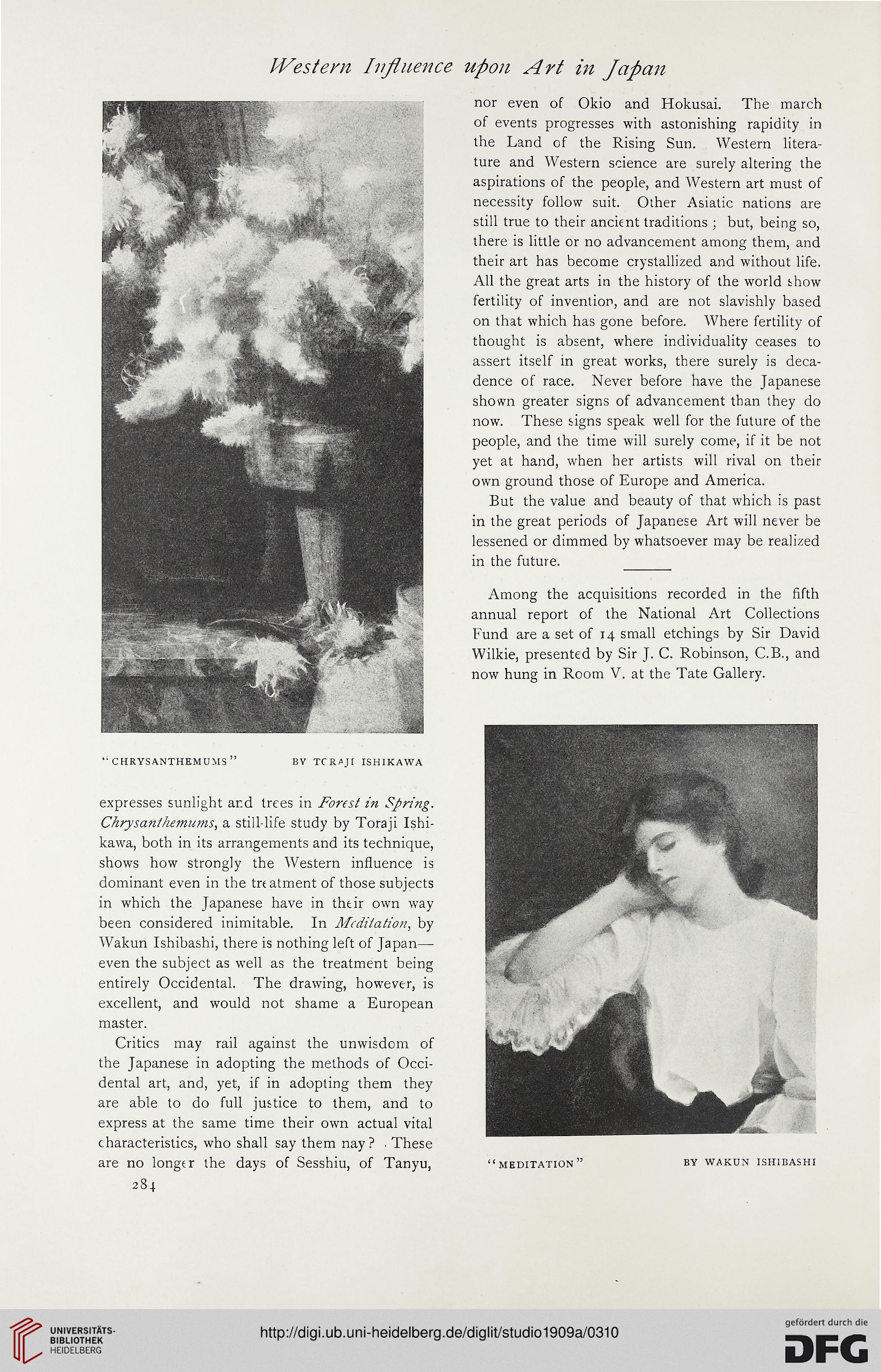IVestern Influence upon Art in Japan
“CHRYSANTHEMUMS” BY TCR/5JI ISHIKAWA
expresses sunlight and trees in Forest in Spring.
Chrysanthemums, a still-life study by Toraji Ishi-
kawa, both in its arrangements and its technique,
shows how strongly the Western influence is
dominant even in the treatment of those subjects
in which the Japanese have in their own way
been considered inimitable. In Meditation, by
Wakun Ishibashi, there is nothing left of Japan—
even the subject as well as the treatment being
entirely Occidental. The drawing, however, is
excellent, and would not shame a European
master.
Critics may rail against the unwisdom of
the Japanese in adopting the methods of Occi-
dental art, and, yet, if in adopting them they
are able to do full justice to them, and to
express at the same time their own actual vital
characteristics, who shall say them nay? , These
are no longer the days of Sesshiu, of Tanyu,
284
nor even of Okio and Hokusai. The march
of events progresses with astonishing rapidity in
the Land of the Rising Sun. Western litera-
ture and Western science are surely altering the
aspirations of the people, and Western art must of
necessity follow suit. Other Asiatic nations are
still true to their ancient traditions ; but, being so,
there is little or no advancement among them, and
their art has become crystallized and without life.
All the great arts in the history of the world show
fertility of invention, and are not slavishly based
on that which has gone before. Where fertility of
thought is absent, where individuality ceases to
assert itself in great works, there surely is deca-
dence of race. Never before have the Japanese
shown greater signs of advancement than they do
now. These signs speak well for the future of the
people, and the time will surely come, if it be not
yet at hand, when her artists will rival on their
own ground those of Europe and America.
But the value and beauty of that which is past
in the great periods of Japanese Art will never be
lessened or dimmed by whatsoever may be realized
in the future.
Among the acquisitions recorded in the fifth
annual report of the National Art Collections
Fund are a set of 14 small etchings by Sir David
Wilkie, presented by Sir J. C. Robinson, C.B., and
now hung in Room V. at the Tate Gallery.
“MEDITATION ”
BY WAKUN ISHIBASHI
“CHRYSANTHEMUMS” BY TCR/5JI ISHIKAWA
expresses sunlight and trees in Forest in Spring.
Chrysanthemums, a still-life study by Toraji Ishi-
kawa, both in its arrangements and its technique,
shows how strongly the Western influence is
dominant even in the treatment of those subjects
in which the Japanese have in their own way
been considered inimitable. In Meditation, by
Wakun Ishibashi, there is nothing left of Japan—
even the subject as well as the treatment being
entirely Occidental. The drawing, however, is
excellent, and would not shame a European
master.
Critics may rail against the unwisdom of
the Japanese in adopting the methods of Occi-
dental art, and, yet, if in adopting them they
are able to do full justice to them, and to
express at the same time their own actual vital
characteristics, who shall say them nay? , These
are no longer the days of Sesshiu, of Tanyu,
284
nor even of Okio and Hokusai. The march
of events progresses with astonishing rapidity in
the Land of the Rising Sun. Western litera-
ture and Western science are surely altering the
aspirations of the people, and Western art must of
necessity follow suit. Other Asiatic nations are
still true to their ancient traditions ; but, being so,
there is little or no advancement among them, and
their art has become crystallized and without life.
All the great arts in the history of the world show
fertility of invention, and are not slavishly based
on that which has gone before. Where fertility of
thought is absent, where individuality ceases to
assert itself in great works, there surely is deca-
dence of race. Never before have the Japanese
shown greater signs of advancement than they do
now. These signs speak well for the future of the
people, and the time will surely come, if it be not
yet at hand, when her artists will rival on their
own ground those of Europe and America.
But the value and beauty of that which is past
in the great periods of Japanese Art will never be
lessened or dimmed by whatsoever may be realized
in the future.
Among the acquisitions recorded in the fifth
annual report of the National Art Collections
Fund are a set of 14 small etchings by Sir David
Wilkie, presented by Sir J. C. Robinson, C.B., and
now hung in Room V. at the Tate Gallery.
“MEDITATION ”
BY WAKUN ISHIBASHI




